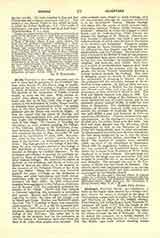

Alcala, UNIVERSITY OF.—This university may be said to have had its inception in the thirteenth century, when Sancho IV, the Brave, King of Castile, conceived the idea of founding a Studium Generale in Alcala de Henares, and (May 20, 1293), conferred full faculties on the Archbishop of Toledo, Gonzalo Gudiel, to carry out this plan. What success attended these efforts is, however, not known; we know only that on July 16, 1459, Pius II gave permission to the Archbishop of Toledo, Alonso Carrillo, to establish some professorships where, “on certain days at the time appointed or to be appointed”, grammar and the liberal arts would be taught. It does not appear that the chairs of theology and canon law were established then, and even grammar was taught only irregularly in the Franciscan convent of San Diego. The honor of founding the University, or, more properly speaking, the College, of San Ildefonso, belongs to the Franciscan, Francisco Ximenez de Cisneros, Prime Minister of Spain, who submitted his plan to Pope Alexander VI, and received his approbation April 13, 1499. Nevertheless, prior to this there existed “certain chairs in some of the faculties”, as he himself says in his petition. The Pope granted to the College of San Ildefonso the same concessions allowed to the College of San Bartolome at Salamanca, and to the college founded at Bologna by Cardinal Albornoz. To the professors and scholars he granted the privileges enjoyed by those of Salamanca, Valladolid, and the other General Colleges. He conferred the degree of Bachelor on the professors, and Doctor of Laws and Master of Arts on the abbot, or, in his absence, on the treasurer, of the Collegiate Church of San Justo and San Pastor. Those who were thus honored enjoyed the same privileges as the professors of Bologna and other universities, and could occupy prebendary stalls for which university degrees were necessary (May 13, 1501). In 1505 ecclesiastical benefices were aggregated to the Collegium scholarium, and January 22, 1512, the archbishop published the statutes of the college. Denifle says that research in Germany regarding this university is incomplete and inexact. Meiners and Savigny know nothing regarding its origin; the dates are not reliable even in Hefele and Gams. Neither can Rashdall’s assertion that “the Universities of Spain were essentially royal creations” (II, pt. I, p. 69) be sustained here. On July 24, 1508, Cisneros went to Alcala with a scholastic colony recruited in Salamanca to found his College of San Ildefonso. The rector was to be chosen by the students (not by the professors, as was the custom at Salamanca) each year about the feast of St. Luke when studies were resumed. The older students were obliged to study theology; civil law was excluded, although the canonists introduced it in the seventeenth century. Besides theology and canon law, the course of study included logic, philosophy, medicine, Hebrew, Greek, rhetoric, and grammar. Demetrio de Creta was engaged to teach Greek, and the mathematician, Pedro Ciruelo, explained the theology of St. Thomas. Cisneros not only founded a university, but built a new town, certain portions of which were devoted to the houses of the students and booksellers. Numerous colleges also sprang up; Santa Catalina and Santa Balbina for philosophers; San Eugenio and San Isidoro for grammarians; and the Trilingue. He erected a hospital in honor of the Mother of God for the students, and established three places of recreation: the Abbey of San Tuy, near Buitrago; the Aldehuela, near Torrelaguna; and Anchuelo, near Alcala. Soon, however, a spirit of insubordination began to show itself in the wrangling of the students with the townspeople, the severe Cisneros apparently showing a strange leniency towards the students. This want of discipline caused the faculty in 1518 to consider the advisability of returning to Madrid. Some of the professors left the university because of the reduction of their salaries. In 1623 an effort was once more made to return to Madrid, but the change was not effected until 1822, and even then it was not permanent, as they returned to Alcala in 1823. The final and definite removal took place in 1836. The revenues left to the College of San Ildefonso by Cisneros reached the sum of 14,000 ducats, and in the sixteenth century reached 42,000, or 6,000 less than those of Salamanca. The celebrated grammarian, Antonio de Nebrija, received 3,333 maravedis a month; the professor of medicine, Dr. Tarragona, was paid 53,000 a year, and Demetrio de Creta an equal sum (100 florins). Cisneros enforced very rigid examinations. In the theological course which was divided into ten terms, there were five tests. The first and most dreaded was the Allonsina, which corresponded to that of the Sorbonne of Paris. Those who failed usually went to other universities. To the successful licentiates letras de orden were given, the first being designated by an L, and the others by superior or inferior letters, according to their merit. The number of students never exceeded 2,000, one-third of the attendance at Salamanca. About 1570 the magnificent building of the university was completed, the twenty-five letters of the motto ET LUTEAM OLIM MARMOREAM NUNC being displayed on as many columns. The patronage exercised by the kings over the universities they had founded or protected led to the sending of visitors and reformers. The principal one sent to the University of Alcala was Don Garcia de Medrano. The reforms which were instituted brought to an end the university autonomy which had been cherished and encouraged by the Catholic Church.
RAMON RUIZ AMADO

